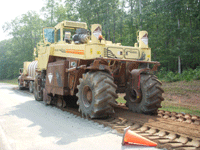By Bob Nickelson, Southeast Cement Association
 As counties are expanding at an exponential rate, they are faced with maintaining more roads with shrinking maintenance funding and increased roadwork costs. Coweta County in Georgia is overcoming this by implementing full-depth reclamation (FDR) with portland cement.
As counties are expanding at an exponential rate, they are faced with maintaining more roads with shrinking maintenance funding and increased roadwork costs. Coweta County in Georgia is overcoming this by implementing full-depth reclamation (FDR) with portland cement.
Coweta’s roads, like other Georgia counties’ roads, were built on a sand/clay base where the asphalt was placed directly over the underlying soil rather than on a rock/aggregate or soil-cement base. This construction technique was used for many years and most roads performed quite well. However, as counties experienced growth, the roads were subjected to heavier loads and began to deteriorate. “Resurfacing a roadway that has a failed base is a waste in time and money,” said Bill Cawthorne, Coweta County public works director. “We had to do something different!”
“With deep-patching contracts now costing the county in excess of $100 per ton of asphalt, full-depth reclamation using cement was an alternative that made sense,” said Fred Landrum, Coweta County transportation project manager. “FDR can rebuild the road in-place in a matter of days and the cost savings are about one-third of traditional methods. We can essentially rebuild an entire section of roadway for relatively the same investment of dollars spent for deep patching.”
Full-depth reclamation with cement makes the reconstruction of roads a largely self-sustaining process. The complete recycling process can be finished in one day, and traffic can be maintained throughout construction. The old asphalt and any existing base material are pulverized, mixed with portland cement and water, and then compacted to produce a strong durable base for either an asphalt or concrete surface. There is no need to haul in aggregate or haul out old material for disposal, reducing construction truck traffic and waste. FDR conserves virgin construction materials, saves fuel, and prevents loaded trucks from tearing up the road.
The process starts by evaluating the condition of the existing pavement including the sub-layers and mix design. Next, pulverization sizes the materials back down to a two- inch minus material. An exact amount of portland cement and water is blended into the material. Reshaping, proper compaction, grading and curing follow. This gives the new base the strength and durability to achieve long lasting, cost effective pavements.
By addressing the entire pavement section, FDR is able to correct delinquent cross sections, widen roads, increase the load-bearing strength of the base, and utilize 100 percent of the existing materials. The process addresses crown and slope corrections, drainage problems, reflective cracking, and rutting and potholing. Substantial savings can be attained while meeting environmental goals. Cement stabilization increases the stiffness and strength of the base material, reducing deflections due to traffic loads that results in lower strains on the asphalt surface and sub-grades. A cement-treated-base also forms a moisture-resistant layer that keeps out water that can destroy untreated aggregate bases, resulting in potholing and alligator cracking.
According to the 20-year research study of the FDR process by the Portland Cement Association, roads reconstructed using the FDR process had a life expectancy up to three-times of non-treated roadways.
“Even before the cost of asphalt went sky high, FDR with cement was a better value than deep patching,” said Landrum. “By utilizing FDR, we are expecting our asphalt investment to double or perhaps triple in longevity.”
In 2007, Coweta County awarded the state’s largest FDR contract—$2.6 million—to the Miller Group based in Morrow, Georgia for reconstructing nearly ten miles of country roads. The county plans to bid an additional ten plus miles this year.